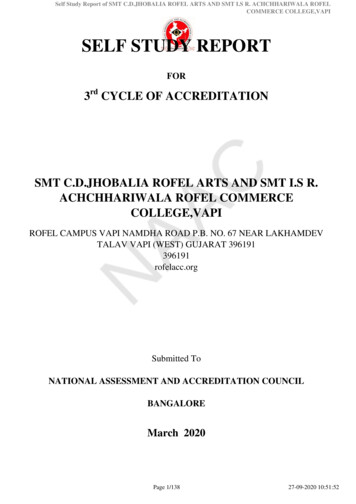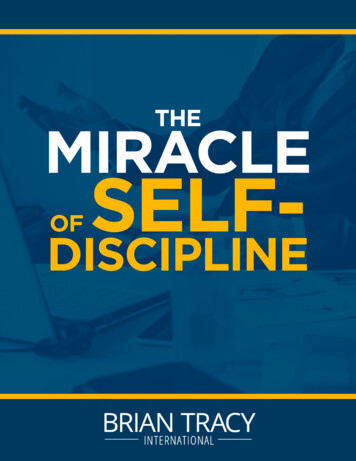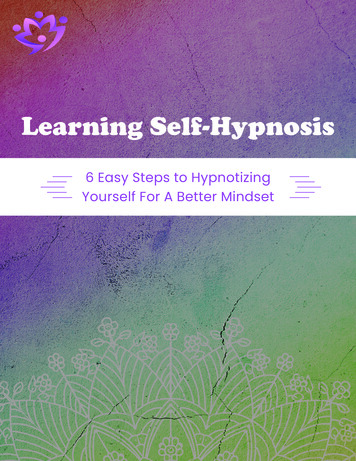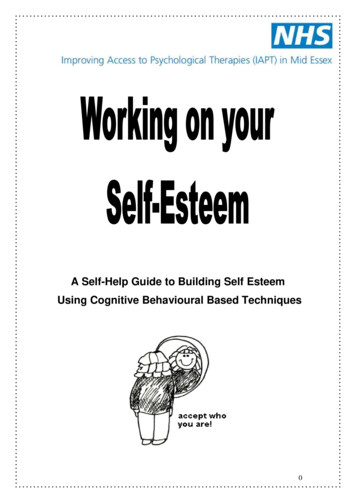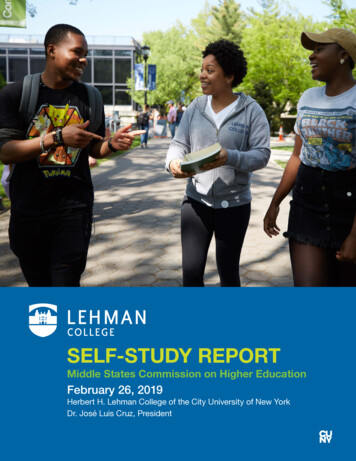
Transcription
SELF-STUDY REPORTMiddle States Commission on Higher EducationFebruary 26, 2019Herbert H. Lehman College of the City University of New YorkDr. José Luis Cruz, President
Herbert H. Lehman CollegeThe City University of New YorkMSCHE Self-StudyTABLE OF CONTENTSLIST OF TABLES AND FIGURES. . iLIST OF EVIDENCE. . .iiiEXECUTIVE SUMMARY . . .1INTRODUCTION .3STANDARD 1: MISSION AND GOALS . . . .8STANDARD 2: ETHICS AND INTEGRITY . .16STANDARD 3: DESIGN AND DELIVERY OF THE STUDENT LEARNING EXPERIENCE .27STANDARD 4: SUPPORT OF THE STUDENT EXPERIENCE. 41STANDARD 5: EDUCATIONAL EFFECTIVENESS ASSESSMENT 55STANDARD 6: PLANNING, RESOURCES, AND INSTITUTIONAL IMPROVEMENT .72STANDARD 7: GOVERNANCE, LEADERSHIP, AND ADMINISTRATION .86CONCLUSIONS AND SUGGESTIONS . 97LIST OF ACRONYMS . . . 98
TABLES AND FIGURESTable 1:Lehman College Historical Fall Enrollment and Degrees Awarded, 1969-2018Table 1.1:Strategic Goals and Objectives for Achieving the Vision by Building a Strong FoundationFigure 1.1:Characteristics of a Lehman GraduateFigure 1.2:Achieving the Vision Alignment with CUNY Master PlanTable 2.1:Promotion and Tenure Information by Job ClassificationFigure 3.1:Pathways – Completion of an Undergraduate DegreeTable 3.1:Selected New Academic Programs Since Academic Year 2015Figure 3.2:Top Declared Undergraduate Majors: Fall 2017Figure 3.3:Top Declared Graduate Majors: Fall 2017Table 3.2Faculty by RankTable 3.3:Student-Faculty Ratio at Lehman College, Select YearsFigure 4.1:Lehman’s Dynamic Community of SupportFigure 4.2:Four-Year Graduation Rate of Students Who Transferred from a CUNY Associate DegreeProgram to a CUNY Baccalaureate ProgramFigure 4.3:Number of Students Who Received Grant of Scholarship Aid and Total Award, SelectYearsFigure 4.4:Percentage of Fall Full-Time Freshmen Retained in the Fall as Full-Time, Select YearsFigure 4.5:Six-Year Graduation Rate of Full-Time, First-Time Freshmen in Baccalaureate Programs,Select YearsFigure 5.1Lehman’s Comprehensive Approach to AssessmentFigure 5.2:Six-Step Assessment ProcessTable 5.1:Characteristics of a Lehman Graduate and Their Relation to General EducationTable 5.2:Average Score by Course – Spring 2018Table 5.3:Percentage of Degree Programs Completing Assessment Reports by Division, 20142015 through 2017-2018 Academic YearsTable 5.4:Nature of AES Unit AssessmentTable 5.5:Administrative, Educational, and Student Support Unit Assessment Activity, SelectYears
Table 6.1Base Budget Allocation Reductions (in Millions), FY2016-FY2019Figure 6.1Lehman College City University Tuition Reimbursable Account (CUTRA) Balance, SelectFiscal YearsTable 6.2:Strategic and Operational Initiatives, FY2017-FY2020Figure 7.1:Lehman College’s Governance StructureTable 7.1:Composition of Lehman College Senate and Requirements
LIST OF EVIDENCEItem 9 Periodic Review ReportIntro.,5Appendix 422009 Self-Study Report3,5,6Appendix 132014 Noel Levitz Survey3Appendix 242014 NSSE Survey2,3Appendix 352014 Periodic Review Report Reviewers' Response5Appendix 562015 COACHE Survey2,7Appendix 672015-2016 PMP Report6Appendix 4082016 CUNY Student Experience SurveyIntro.,3Appendix 792016-2017 PMP Report6Appendix 40102017 CIRP Survey3Link112017 Convocation Speech1,6Appendix 8122017 State of the College Address1,6Portal132017-2018 PMP Data Book142017-2018 PMP Letter152018 Committee on Higher Education Testimony3Portal162018 Student Success Workshop Agenda3Appendix 28172018 Student Success Workshop Slides3Appendix 291890x30 Initiative OverviewIntro.,1,2,5,6Portal19ACE Report20Achieving the Vision21Administrative Leadership Forum Meeting Agenda6Portal22ADP Self-Study Report5Appendix 3723Advancing the VisionIntro. 1,5,6Appendix 1324AES Unit Inventory5Appendix 3425Articulation Agreements4Link26Assessment of Quantitative Reasoning5Appendix 1427Assessment Workshops5Appendix 33iiiIntro.,3,4,6Appendix 24Intro., 1,3,4,5,7Appendix 25Intro.Appendix 38Intro., 1, 2,5,6Appendix 12
28Assessments of Outstanding Skills in Diverse Media5Appendix 1529Bylaws of the Herbert H. Lehman College Association7Portal30Cabinet Biographies7Link31Characteristics of a Lehman Graduate1,2,5Appendix 1632College Governance Documents5,7Portal33Connected CUNY1,4Portal34Constitution of the SGA7Link35CUNY Budget Process6Appendix 1736CUNY Bylaws2,3,7Portal37CUNY College Assistant Handbook2Link38CUNY Conserves Initiative6Link39CUNY Manual of General Policy2Link40CUNY Master Plan1,6Portal41CUNY Operating Budget Letter6Link42CUNY Pathways Program3,4Portal43CUNY Technology Literacy Statement5Portal44CUNY University Faculty Statement on Academic Freedom2Link45CUNY-PSC Collective Bargaining Agreement2,7Link46CUNY-PSC Handbook for CLTs2,7Link47Demystifying the Rubric Workshop Agenda5Link48Flipped Classroom Study5Appendix 3649Future of Assessment Document (AAC)5Appendix 1850FY 2018 CUNY Audit6Appendix 1951General Education Strategic Plan1Link52Graduate School Destinations of Lehman Graduates5Portal53Guaranteed Admissions Agreements4Link54Lehman College Academic Assessment Report 2017-182,5Appendix 1055Lehman College Academic Master Plan3Link56Lehman College Academic Program Review Guidelines3,5Appendix 2057Lehman College Accomplishments Slide Deck7Portaliv
58Lehman College AES Assessment Report 2017-182,4,5Appendix 1159Lehman College Annual Security Report2Link60Lehman College Appeals Process2Link61Lehman College Facility Master Plan Update, 20026Portal62Lehman College Facility Master Plan6Portal63Lehman College Fact Book 20172,4,5,6Appendix 964Lehman College Faculty Handbook2,7Link65Lehman College Financial Report and Forecast6Appendix 2166Lehman College General Education Requirements3Link67Lehman College HEO Handbook2,7Link68Lehman College I.T. Roadmap, 2018-20196Link69Lehman College Labor Data Brief3,4Appendix 2270Lehman College Online Learning Data3Portal71Lehman College Operating Budget6,7Portal72Lehman College Organizational Structure7Appendix 2373Lehman College Senate Bylaws2Link74Lehman College Statement on Academic Freedom2Link75Lehman College Student Handbook2,7Link76Lehman College Swing Space Study, 20106Portal77Lehman College Undergraduate Bulletin3Link78Lehman College VP for Administration & Finance Posting2Portal79Lehman Forward1Portal80Lehman Process Automation6Portal81Lehman Technology Fee6Link82List of Recently Approved Academic Programs3Portal83Membership of the Strategic Planning Council1,6Portal84Mission, Vision, Values Commmittee Memo1Portal85Momentum Newsletter, November 20186Portal86MSCHE Executive CommitteeIntro.Portal87MSCHE Self-Study Design DocumentIntro.Linkv
Intro.PortalPresidential Priorities1Portal90President's Biography7Link91Quantitative Reasoning Overview3Link92Release Time for Assessment5Appendix 2793Sample Degree Maps4Portal94School of Education Assessment: 2011-12 through 2013-145Portal (.XLSX)95School of Education Assessment 2015-16 through 2017-185Portal (.XLSX)96Senate Committee on Budget and Long Range Planning7Link97Sophomore Year Initiative Proposal4Portal98Specialized Accreditations3Link99Strategic Funding1,6Appendix 26100Strategic Planning Council Cabinet Retreat Agenda1Portal101Strategic Planning Council Report1Appendix 35102Student Affairs Accomplishments4Appendix 39103Supplemental Academic Assessment Report5Appendix 32104Tenure and Promotion Checklist3Portal105U.S. DOE Audit Correspondence6Appendix 30106University of Chicago Statement on Free Expression2Portal107Verification of Compliance Report, 20196Appendix 31108Voice Vote on Free Expression2Portal109Writing Across the Curriculum Overview3Link88MSCHE Steering Committee89Note: Supporting evidence and documentation for the Self-Study are included in the Appendix. At the request ofthe Site Visit Chair, materials included in the attached Appendix represent the core documents of the Self-Study. Amore comprehensive body of evidence has been uploaded into the MSCHE Portal and is available by request.vi
EXECUTIVE SUMMARYHerbert H. Lehman College is guided by the tenets of promoting student success, equity, andupward mobility through delivery of a high-quality education of value by a vibrant and caringacademic community. The College takes pride in its ability to transform the people,community, and economy of the Bronx. To do so well requires an intentional approach toinstitutional effectiveness.Lehman’s institutional Self-Study process began in Fall 2015 when the Co-Chairs of the SteeringCommittee began conducting workshops on methods for improving campus processes andresource allocation with constituents from the entire community. Additional workshops onMiddle States Commission on Higher Education (MSCHE) Standards and the Self-Study processwere held with each division and School. Important campus forums were used to highlight theSelf-Study as an opportunity for campus renewal. By Fall 2016, the Steering Committee and allWorking Groups had been charged, and meetings to discuss design and model of the Self-Studyand Working Group goals had taken place. Members of the Steering Committee and WorkingGroup leadership had attended multiple Town Halls meetings and the MSCHE AnnualConference. Together, these groups produced a draft Self-Study. Due in part to personneltransitions, in Summer 2018 President Cruz added more faculty members to the 30-memberSteering Committee to better represent the campus. He also appointed a five-person ExecutiveCommittee to guide this body. The Self-Study received endorsement from the SteeringCommittee on January 22, 2019, and the College Senate on February 6, 2019.Lehman leveraged the MSCHE Standards for Accreditation and Requirements of Affiliation as itsframework for the Self-Study, maximizing their interconnected nature to investigate whetherthe College was fostering student success through a continuous, evidence-based approach tosupporting, enhancing, and improving the student experience, as well as the systems,processes, and structures that support it. The MSCHE Standards and Lehman’s guidingprinciples shaped formation of the Steering Committee in addition to Working Groups for eachStandard. Each Working Group was composed of a diverse group of faculty, staff, andadministrators guided by the College’s MSCHE Self-Study Design Document. After anintroduction to Lehman College and an overview of the self-study process, the study consists ofeight sections, one for each of the MSCHE standards, and a concluding chapter that outlinessuggestions for further reflection and renewal, as described below.Standard 1: Mission and Goals. This section provides a detailed review of the processundertaken to create Lehman’s most recent Strategic Plan, Achieving the Vision, includingunderlying goals, strategies, and objectives. More recent efforts to update the plan and othercritical strategic efforts, such as the College’s 90x30 Challenge are also described. This sectionexplores how the College’s Mission, Vision and Values were developed, and how these strategicefforts impact student success, influence decision-making, and are aligned with the strategicand operational priorities of the College.1
Standard 2: Ethics and Integrity. This section reviews: the College’s policies, procedures, andstructures to determine their impartiality; examines whether appropriate rights andprotections are granted to students, faculty, and staff; and explores the extent to which theCollege communicates with its constituents in transparent ways that value diversity andinclusion, and promote respect.Standard 3: Design and Delivery of the Student Learning Experience. This section examines:effectiveness of Lehman’s academic programs and General Education core; currency andrelevancy of its curriculum; number and qualifications of faculty, including adjuncts; whetherand to what extent faculty is supported; and how well the College prepares students foracademic and post-graduate success, regardless of modality, level, setting, and program pace.Standard 4: Support of the Student Experience. The capacity to optimize resources, planeffectively, and align people, processes, and technology in pursuit of its mission and goals arevitally important for Lehman. This section presents the effectiveness of the College’s policies,practices, and services designed to support access, retention, graduation, and post-graduatesuccess for native and transfer students alike. It also investigates how these services convergeto enhance teaching, learning, and advising.Standard 5: Educational Effectiveness Assessment. Lehman has always taken great pride inproviding an affordable education of quality, rigor, depth, and breadth. The College maintainscomprehensive systems of continuous improvement and assessment designed to promotestudent success and learning, and academic quality and renewal in direct and indirect ways.This section describes and examines Lehman’s Institutional Learning Domains, InstitutionalLearning Outcomes, Program Learning Goals, and Student Learning Objectives, in addition toassessment structures, processes, and efforts. As a result of this examination, a number ofopportunities to further strengthen the College’s assessment structures are identified.Standard 6: Planning, Resources, and Institutional Improvement. Lehman’s institutionaleffectiveness approach is shaped by its commitment to student success and equity, and acontinuous approach to supporting, and improving the student experience – including theprocesses, and structures that support it – using evidence. This section discusses assessment ofAdministrative, Educational, and Student Support (AES) units, strategic and operational plans,resource stewardship, determining to what extent they are aligned with the College’s goals.Standard 7: Governance, Leadership, and Administration. This section provides an overviewof the College’s governance structures and how they promote organizational stability. Thisincludes: mechanisms that exist to allow for student, faculty, and staff input into organizationalstrategy and decision-making; relationship between Lehman College and The City University ofNew York (CUNY); and how the College maintains qualified leadership and administration toguide its daily operations using evidence.Conclusions and Suggestions. This final section outlines findings of the College’s Self-Study andevaluation, with a focus on a series of suggestions intended to facilitate organizational renewal.2
INTRODUCTIONInstitutional History and TypeHerbert H. Lehman College – a Carnegie-classified Master’s Colleges & Universities: LargerPrograms – is the only public senior college in the Bronx. Lehman College is part of The CityUniversity of New York, which is comprised of eleven senior colleges, seven communitycolleges, and seven honors, graduate and professional schools. The College was established onJuly 1, 1968, after existing since 1931 as the Bronx branch of Hunter College, known as Hunterin-the-Bronx. It is named for Herbert H. Lehman, former Governor of New York State, U.S.Senator, and internationalist. His values of dedicated public service, commitment to humanrights, and support for immigrants are embodied in many of the College’s programs andinitiatives today.In the decades that followed its founding, Lehman – located on a 37-acre tree-lined campus –continually evolved in response to the end of free tuition at CUNY, and a changing social,political, and economic landscape. As a consequence, it ably endured the iconic studentprotests of the late 1960s and 1980s, as well as New York City’s fiscal crisis of the mid-1970s,which resulted in faculty retrenchment and reduced capital investment in college campuses.Today, as described in ensuing sections, the College is energized and ready to redouble itsefforts to respond to the very real environmental, economic, and social challenges of the day.New York State and CUNY have invested heavily in the College’s physical plant including:opening of Carman Hall, Lehman’s principal classroom building (1971); Lehman Center for thePerforming Arts (1980); and the Multimedia Center (2010). These are complemented by theArt building (1959), Leonard Lief Library (1980), and APEX gymnasium (1994).The original campus core consists of the neo-Gothic towers and tree-lined walkways thatresonate to in 1946 when it served for six months as the interim headquarters for the newlyformed United Nations. The College has made recent changes to its physical plant. ScienceHall, the College’s state-of-the art research and teaching facility, debuted in 2012. In 2013, inrecognition of the needs of the College’s distinctive student body, the Child Care Center wasinaugurated in a separate building. The largest ongoing project is a 64 million, 50,000 squarefoot Nursing Education, Research, and Practice Center.Student Population and Academic ProgramsIn 2016, President José Luis Cruz was appointed the third President of Lehman College,following the 26-year tenure of President Ricardo Fernández. Since then, the College hasexperienced growth in both enrollment and degrees awarded, as highlighted in Table 1.3
Table 1: Lehman College Historical Fall Enrollment and Degrees Awarded [Select 1810,04113,32914,13014,787NA2,9182,8603,194 Notes: *Data not available. Pending CUNY Central validation.With over 81,000 alumni – more than half remaining in the community and region, giving backand strengthening their communities as financial analysts, health care professionals,information technology practitioners, social workers, teachers, and elected officials – Lehmancurrently enrolls nearly 15,000 undergraduate and graduate students, its largest enrollment inover 40 years. Moreover, 3,194 degrees were awarded in 2018, double the number awardedtwo decades prior.Lehman College offers 140 degree programs with a firm foundation in liberal arts and sciencesthat include 76 undergraduate majors and programs and 64 graduate degree programs.Lehman also offers 33 graduate certificates. Currently, the five undergraduate majors with thehighest number of declared students include Nursing (946), Business Administration (857),Psychology (772), Sociology (630), and Health Services Administration (588). Lehman’s degreeprograms respond to the College’s core identity as a liberal arts institution committed todeveloping in students the critical skills and competencies they need for sustained, successfulcareers in the constantly changing 21st century workplace, as well as function as responsibleglobal citizens. To this end, Lehman has invested in technology and multimedia resources,providing equipment, support, and professional development and certification for webenhanced instruction in the traditional classroom and for hybrid/online courses and programs.Characteristics of Lehman’s undergraduate and graduate students (2017): (1) Of 11,978undergraduates, 52.5% are Hispanic, 30.3% are Black, and 6.9% are Asian. Sixty-eight percentare women. The average age is 26. (2) Of 2,152 graduate students, 34.7% are Hispanic, 31.2%are Black, and 6.7% are Asian. The average age is 34. (3) Six in ten undergraduates are enrolledfull-time. Forty-nine percent of undergraduate students are first-generation. (4) Nearly 60%(58.9%) of undergraduate students and 43% (42.5%) of graduate students reside in the Bronx.Lehman College is committed to success of its ethnically and socially diverse studentpopulation, providing optimal advising, education, and opportunity for students across theenrollment spectrum – from Search for Education, Elevation, and Knowledge (SEEK) to Honorsstudents, from first-year through transfer majors to graduate students.4
Pivotal to providing these offerings are Lehman’s 1,549 employees, consisting of 956 faculty(full-time and part-time) and 593 staff. The College’s nationally recognized faculty, whichincludes five Distinguished Professors, reside in the College’s five Schools – Arts andHumanities; Continuing and Professional Studies; Education; Health Sciences, Human Services,and Nursing; Natural and Social Sciences – where they serve as scholar-teachers, engaging withstudents in the latest disciplinary research and analysis.Lehman takes great pride in the diversity as well as productivity of its faculty. Roughly 37% offull-time faculty are faculty of color, which represents a 10% increase in the proportion of fulltime faculty of color since 2010. The College expects this percentage to increase over time,given its emphasis on excellence, equity, and inclusion in hiring practices, as well as increasedpresence of students of color in Doctoral programs across the country.In addition to its matriculated student population (including Adult Degree students), Lehmanserves 13,000 students through its School of Continuing and Professional Studies (SCPS). TheSchool offers 33 high-quality certificates and licenses. Its programs include an Innovation Lab,Small Business Development Center, ESL training, and education labs for high school students.This programming reflects Lehman’s commitment to educational attainment in its homecommunity, throughout the cradle-to-career pipeline, one of many factors that makes theCollege an anchor institution in the Bronx.Over the past decades, Lehman has undertaken multiple planning cycles, culminating in the2018-2019 Self-Study, which will serve as the springboard to a new Strategic Plan for 20202025. These efforts include: the 2009-2019 Strategic Planning Council Report (Appendix 35);Lehman’s most recent Strategic Plan, Achieving the Vision (2010-2020) (Appendix 12); 2014MSCHE Periodic Review Report (Appendix 4); and 2013-2016 Prioritization Initiative (Appendix13). Building on recent economic gains in the Bronx, the findings of these planning efforts – inconjunction with information gathered during the College’s presidential transition in Fall 2016 –resulted in articulation of the aspirational 90x30 Challenge aimed at doubling the number ofdegrees and credentials awarded by Lehman College between 2015 and 2030 from 45,000 to90,000.The 90x30 Challenge builds on the College’s established ability to promote upward economicmobility, and is consistent with the four major goals of the 2010-2020 Strategic Plan: 1)Excellence in teaching, research, and learning; 2) Enhanced student success; 3) Greaterinstitutional and financial effectiveness; and 4) Commitment to community engagement andservice. Moreover, these institutional priorities are embodied in Lehman’s mission, whichemphasizes the College’s unique role as an anchor institution that serves the people,community, and economy of the Bronx:Lehman College serves the Bronx and surrounding region as an intellectual, economic,and cultural center. Lehman College provides undergraduate and graduate studies inthe liberal arts and sciences and professional education within a dynamic research5
environment, while embracing diversity and actively engaging students in theiracademic, personal, and professional development.Furthermore, the College’s goals and institutional priorities are geared toward strengthening itscontributions to the advancement of CUNY’s stated mission, which reads in part:“ [T]he University will continue to maintain and expand its commitment to academicexcellence and to the provision of equal access and opportunity The City University isof vital importance as a vehicle for the upward mobility of the disadvantaged in the Cityof New York.”The sharpened focus and intentional efforts of an engaged senior academic leadership teamand continuity of a distinguished cohort of academic chairs has fueled a college that is movingforward and trending upward: Access and Opportunity: The Fall 2017 full-time freshman class (919) was Lehman’s largestin nearly a decade, transfer student enrollment rose slightly, and total student enrollmentwas the largest since 1976 when CUNY’s free tuition policy was discontinued. Moreover, inthe four years between Fall 2013 and Fall 2017, the number of undergraduate STEM majorsgrew by 96%, the highest rate in all of CUNY. Nearly 22% (21.9%) of Lehman’s instructionalfull-time equivalents are taught either partially or fully online, the highest percent of anycollege in the system and more than double the senior college average (10.6%). Appendix 9and (Appendix 25) Retention and Graduation Rates: The proportion of first-time, full-time freshmen whoreturned as full-time students (79.5%) in Fall 2017 outpaced the senior college average(69.9%) by almost ten points. The six-year graduation rate for the first-time, full-timefreshmen 2011 cohort increased 8.6% compared to the Fall 2007 cohort (45.6% vs. 37%), thelargest growth rate of any CUNY senior college during this period. The four-year graduationrate of students who transferred to Lehman from a CUNY Associate degree program in Fall2013 was 58.3%, 7.5 percentage points higher than the CUNY average(50.8%). (Appendix 25) Financial Health: In 2017, Lehman registered a five-year high in spending of its tax levybudget on student services, instruction, and department-level research (69.5%). (Appendix24) Between FY2013 and FY2017, the number of funded research grants increased from 16to 39. In addition, the amount of private financial support received by the College duringthat period grew 84.4% from 5.7M to 10.7M. (Appendix 25) Recent investments(November 2018) include a 4.2 million award from the Robin Hood Foundation to support250 students in the new Accelerate, Complete, Engage (ACE) completion program, starting inFall 2019 with the goal of achieving 50% four-year graduation rates for freshmen andtransfers with Associate degrees. Public-Private Partnerships: Lehman opened the first Virtual and Augmented RealityAcademy and Lab in the region with Eon Reality, and received a major grant from the6
Economic Development Corporation to provide additional workforce development as partof a three-year partnership with New York University. Value: Forbes recently set out to identify “the schools where grads owe the least relative totheir likely mid-career income.” Lehman was one of only four public colleges to rank in thetop 25 “low-debt/high-income schools.” Social Mobility: According to the American Council of Education, Lehman has the highestextended mobility rate, measured as the fraction of students who come from families in thebottom two income quintiles and end up in the top two quintiles as adults, among allHispanic-serving institutions. Similarly, recent data from National Bureau of EconomicResearch and the Equality of Opportunity Project ranked Lehman as having the third highestmobility rate in the nation among Hispanic-Serving Institutions (HSIs). (Appendix 38) Student Satisfaction: According to CUNY’s most recent Student Experience Survey (2016),77% of Lehman students were very satisfied or satisfied with their overall academicexperience, higher than the proportion of comparable responses for both senior colleges(68%) and the entire system (72%). In addition, 72% of Lehman students would eitherdefinitely or probably choose to attend Lehman again if they were to start over, higher thanthe proportion of comparable responses for both senior colleges (60%) and the entiresystem (63%). (Appendix 7) Educational Attainment: In 2018, just one year after launching 90x30, the number ofdegrees and professional certificates earned by Lehman students increased by 12%, farexceeding the annual growth rate required to meet the challenge.7
STANDARD 1: MISSION AND GOALSSince Lehman College’s establishment in 1968, it has been guided by the tenets of promotingstudent success, equity, and upward mobility through delivery of a high-quality education ofvalue by a vibrant and caring academic community. These themes helped steer development ofthe College’s most recent Mission Statement, approved by the Senate on May 16, 2007following a three-year process of campus consultation.This process was led by the Mission, Vision, and Values Committee, consisting of eleven facultyand staff. To ensure creation of a new Mission Statement was inclusive, drafts were sharedwith the College Senate, Faculty Personnel and Budget Committee, MSCHE Steering Committeeand Working Groups, the Lehman College Foundation Board, and the college community. Thisresulted in the following Mission Statement:The College’s mission is to serve the Bronx and surrounding region as anintellectual, economic, and cultural center. Lehman College providesundergraduate and graduate studies in the liberal arts and sciences andprofessional education within a dynamic research environment, while enhancingdiversity and actively engaging students in their academic, personal, andprofessional development.The revised Mission Statement was accompanied by the College’s first Vision and ValuesStatements, well aligned with Lehman’s Institutional Learning Goals (see Figure 1.1). Togetherthese components helped launch Lehman’s current Strategic Plan, Achieving the Vision byBuilding a Strong Foundation (Achieving the Vision) (2010-2020). (Appendix 12) Plans forAchieving the Vision began in September 2008, when former President Ricardo Fernándezprovided the 21-member Strategic Planning Council (SPC), composed of faculty, staff, andstudents, the formal charge of creating the College’s new Strategic Plan.Over the course of 18 months, the SPC engaged the campus community through workinggroups and tailored outreach. Input from these meetings resulted in the Strategic PlanningCouncil Report (January 2010) (Appendix 35), which included the following institutional goalsdesigned to address intern
7 2015-2016 PMP Report 6 Appendix 40 8 2016 CUNY Student Experience Survey Intro.,3 Appendix 7 9 2016-2017 PMP Report 6 Appendix 40 10 2017 CIRP Survey 3 . Link. 11 2017 Convocation Speech 1,6 Appendix 8 12 2017 State of the College Address 1,6 Portal 13 Intro.20



